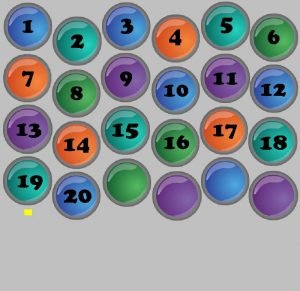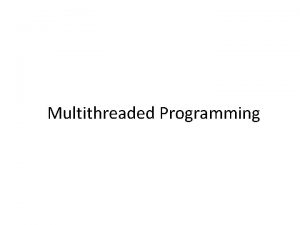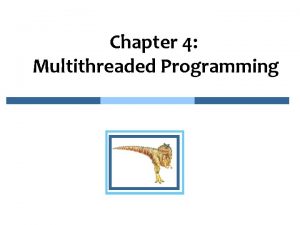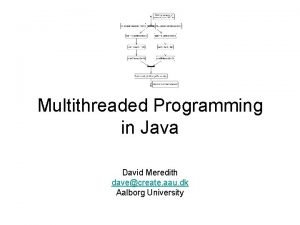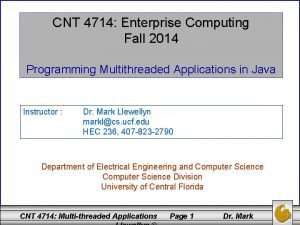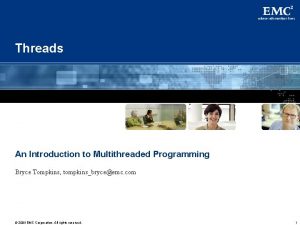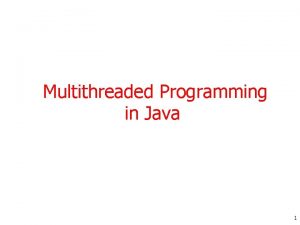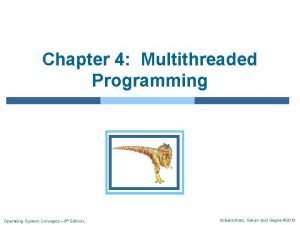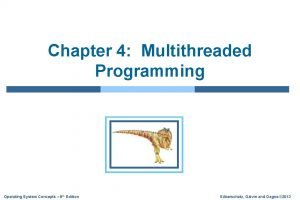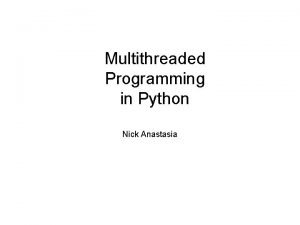Multithreaded Programming A multithreaded program contains two or


































- Slides: 34

Multithreaded Programming • A multithreaded program contains two or more parts that can run concurrently. • Each part of such a program is called a thread, and each thread defines a separate path of execution. • This means that a single program can perform two or more tasks simultaneously. • Multithreading enables you to write very efficient programs that make maximum use of the CPU

Thread Class and Runnable Interface • Java’s multithreading system is built upon the Thread class, its methods, and its companion interface, Runnable • To create a new thread, your program will either extend Thread or implement the Runnable interface.

The Main Thread • When a Java program starts up, one thread begins running immediately. This is usually called the main thread of your program. • The main thread is important for two reasons: – It is the thread from which other “child” threads will be spawned. – it must be the last thread to finish execution because it performs various shutdown actions. • Main thread can be controlled through a Thread object. To do so, you must obtain a reference to it by calling the method current. Thread( ). • static Thread current. Thread( )


• static void sleep(long milliseconds) throws Interrupted. Exception • final void set. Name(String thread. Name) • final String get. Name( ) Creating a Thread • You can implement the Runnable interface. • You can extend the Thread class, itself.

Implementing Runnable • The easiest way to create a thread is to create a class that implements the Runnable interface. • To implement Runnable, a class need only implement a single method called run( ), which is declared like this: public void run( ) • Run() is the entry point for new thread. • The thread will end when run( ) returns. • Thread defines several constructors. • Thread(Runnable thread. Ob, String thread. Name) • After the new thread is created, it will not start running until you call its start( ) method • start( ) executes a call to run( ).



Extending Thread • The second way to create a thread is to create a new class that extends Thread • The extending class must override the run( ) method, which is the entry point for the new thread. • It must also call start( ) to begin execution of the new thread.



Creating Multiple Threads



Using is. Alive( ) and join( ) • final boolean is. Alive( )-returns true if the thread upon which it is called is still running. It returns false otherwise. • final void join( ) throws Interrupted. Exception – waits until the thread on which it is called terminates. – Its name comes from the concept of the calling thread waiting until the specified thread joins it.




Thread Priorities • To set a thread’s priority, use the set. Priority( ) method, which is a member of Thread. • This is its general form: final void set. Priority(int level) • The value of level must be within the range MIN_PRIORITY and MAX_PRIORITY. • Currently, these values are 1 and 10, respectively. • To return a thread to default priority, specify NORM_PRIORITY, which is currently 5. • You can obtain the current priority by calling the get. Priority( ) • final int get. Priority( )



Synchronization • When two or more threads need access to a shared resource, they need some way to ensure that the resource will be used by only one thread at a time. The process by which this is achieved is called synchronization. • Key to synchronization is the concept of the monitor (also called a semaphore). • A monitor is an object that is used as a mutually exclusive lock, or mutex. • Only one thread can own a monitor at a given time. • When a thread acquires a lock, it is said to have entered the monitor. • All other threads attempting to enter the locked monitor will be suspended until the first thread exits the monitor.



Using Synchronized Methods

The synchronized Statement This is the general form of the synchronized statement: synchronized(object) { // statements to be synchronized }

Interthread Communication • wait( ) tells the calling thread to give up the monitor and go to sleep until some other thread enters the same monitor and calls notify( ). • notify( ) wakes up a thread that called wait( ) on the same object. • notify. All( ) wakes up all the threads that called wait( ) on the same object. One of the threads will be granted access.







 Multithreading program in java
Multithreading program in java Jumlah level dalam gambar ini adalah . . . .
Jumlah level dalam gambar ini adalah . . . . Multithreaded games
Multithreaded games Multithreaded algorithms
Multithreaded algorithms Apt multithreaded
Apt multithreaded Advantages of absolute loader
Advantages of absolute loader Perbedaan linear programming dan integer programming
Perbedaan linear programming dan integer programming Greedy programming vs dynamic programming
Greedy programming vs dynamic programming Definition of system programming
Definition of system programming Linear vs integer programming
Linear vs integer programming Programing adalah
Programing adalah Shiva drove a silver toyota
Shiva drove a silver toyota Which region contains the halogen family of elements
Which region contains the halogen family of elements Simple predicate
Simple predicate This sentence contains an example of a my little brothers
This sentence contains an example of a my little brothers Which list of elements contains two metalloids
Which list of elements contains two metalloids Which list of elements contains two metalloids
Which list of elements contains two metalloids Simple predicate
Simple predicate A typical programming tasks can be divided into two phases
A typical programming tasks can be divided into two phases Differences between sequential and event-driven programming
Differences between sequential and event-driven programming Perangkat lunak komputer disebut juga dengan.
Perangkat lunak komputer disebut juga dengan. Menyusun program tahunan dan program semester
Menyusun program tahunan dan program semester Microsoft excel merupakan program aplikasi ... *
Microsoft excel merupakan program aplikasi ... * Program pengolah angka pada microsoft windows adalah
Program pengolah angka pada microsoft windows adalah Langkah langkah memulai microsoft word
Langkah langkah memulai microsoft word Polynomial addition using linked list
Polynomial addition using linked list Two nonadjacent angles formed by two intersecting lines
Two nonadjacent angles formed by two intersecting lines Little hands and little feet
Little hands and little feet 1910 134
1910 134 Two + two = four cryptarithmetic
Two + two = four cryptarithmetic Close reading workshop
Close reading workshop Angle pair relationships
Angle pair relationships When two curves coincide the two objects have the same
When two curves coincide the two objects have the same Identify a key term used in both passages.
Identify a key term used in both passages. Vertical angle
Vertical angle












